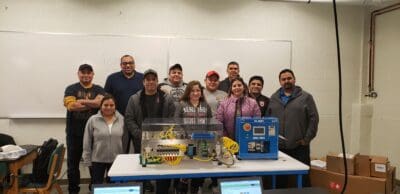Goshen College is uniquely suited to host GOAL, because it has worked hard in recent years to recruit and retain Latinx students. College administrators say that in the next couple of years, Goshen expects to receive the U.S. Department of Education’s Hispanic-Serving Institution designation, which is conferred on schools where Hispanic students account for the equivalent of at least 25 percent of the full-time undergraduate enrollment.
GOAL classes, which typically have between 15 and 18 students, meet once a week for three hours over 30 weeks, and students are required to do six hours of weekly online study as well. The CPT curriculum is divided into four modules, and each prepares learners for a separate credential. Passing all four yields the CPT certification.
Participants all receive Chromebooks to ensure that they are able to access the online curriculum, and they can keep the computers after they complete the program. Students who don’t have internet connections at home use public Wi-Fi in places like restaurants, cafes, and local libraries, said Stith. The sessions overlap—a new cohort starts every six weeks—so students who have trouble with one module or don’t pass the assessment can repeat the subject content with the following cohort.
Recruitment
Campos is the primary person responsible for recruiting students, and her extensive connections in the Latinx community are key to the program’s success, according to Stith. “The Hispanic community is very tight-knit, and Luna is very involved in this community—in a health coalition, the churches, and civic organizations,” she said. “They trust her, and the program has a good reputation.”
The fact that HEA’s GOAL program is based at Goshen College, which has an excellent reputation within the Latinx community, is “huge,” Stith added—especially in an era when some immigrants are wary of American institutions. GOAL has also done some advertising—including on a Latinx radio station—but word of mouth has proved to be the most effective recruitment tool.
Job Placement
HEA has good relationships with local manufacturers (some of its board members are manufacturing executives), and it has leveraged those connections in its GOAL job placement efforts. The organization has spent a lot of time educating employers about GOAL, and about a dozen advanced manufacturing companies have pledged to interview any student who completes the program.
“Most of these companies are larger manufacturers in the transportation industry,” Stith said. “We’re still working on educating the smaller and mid-sized companies about GOAL.”
She says it’s too early to draw definitive conclusions about the impact of the GOAL program on graduates’ careers, but anecdotal evidence indicates that participation benefits people in the job market.
For example, after a line worker named Javier completed the GOAL program, his employer, a manufacturer of high-quality furniture and transportation-related interiors, chose him to be part of its bilingual apprenticeship program. “They’re going to expose him to many aspects of the business—marketing, accounting, the whole nine yards,” said Stith. “They have a path set up for him that’s really exciting.”
Javier’s experience with GOAL was so positive that he also plans to take some college courses. Unfortunately, about 30 percent of HEA GOAL participants do not complete the program for reasons that range from working too much overtime to moving out of the area.
However, in addition to the possibility of improved job prospects, those who successfully complete the program will also have an opportunity to continue their education at Ivy Tech Community College in Elkhart, which plans to open a new, $3.8 million facility for advanced automation and robotics in 2021. Ivy Tech will award six hours’ worth of credits to students who have the CPT certification.
According to Stith, GOAL has been a game-changer for the northern Indiana business community and beyond. “It’s opened everyone’s eyes to an untapped resource — our Hispanic population,” she said. “The program has also been important to Hispanics, showing them that they’re valued and that the community is committed to helping them improve their economic situation.”
And the impact could extend beyond manufacturing into other sectors of the economy. HEA is looking at the possibility of incorporating bilingual instruction into more of its training programs, including its certified nursing assistant courses.


